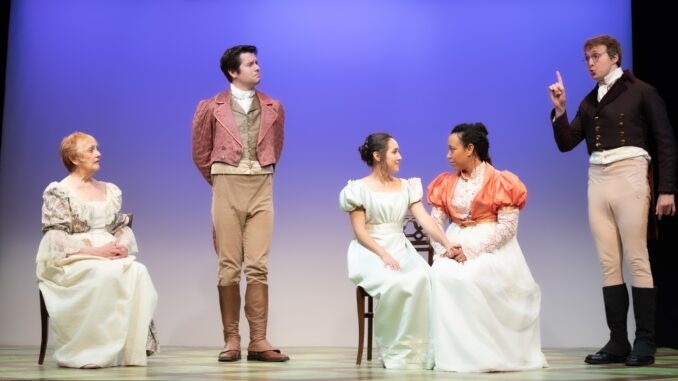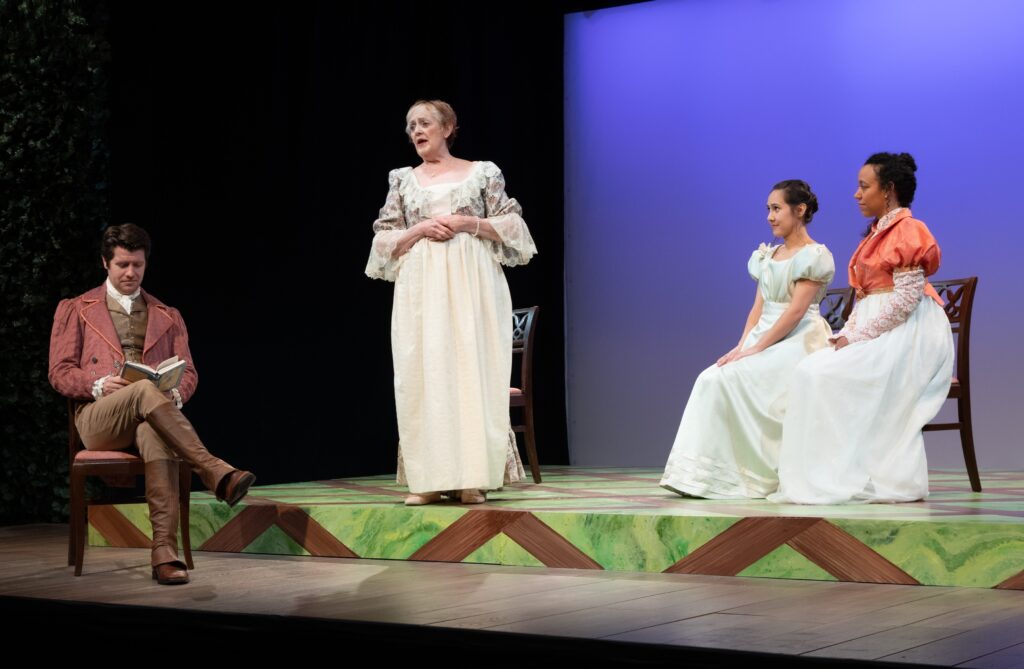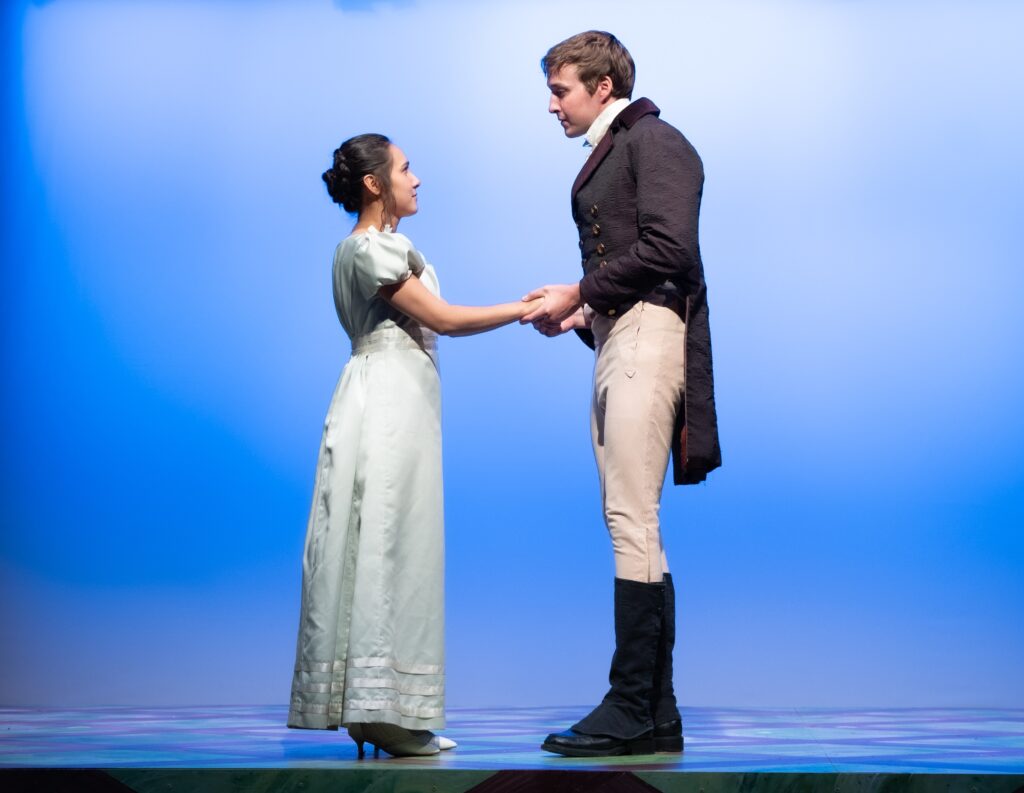

The writer Jane Austen never published a novel in her name during her lifetime; having a writing career was considered inappropriate for a woman of her standing. In addition, the way she skewered the social class in which she circulated was somewhat scandalous at the time. Sense and Sensibility, Austen’s first published novel, was written “By a Lady,” and since it sold well, her next novel, Pride and Prejudice, published in 1813, was credited to “The Author of Sense and Sensibility.”
This second book of the Austen oeuvre serves as the basis of the clever play Pride@Prejudice, currently in production at Chester Theater Company in the Berkshires through July 3. CTC first staged the play in 2011; playwright Daniel Elihu Kramer, unassociated with the company at that time, now serves as CTC’s producing artistic director. He picked an opportune moment to remount this work, given the popularity of the Netflix series Bridgerton, which shares the novel’s Regency time period, wry tone, handsome, brooding bachelors and smart, strong-headed heroines, plus will they/won’t they storylines—and is anchored by the social commentary of an anonymous female writer, Lady Whistledown.
While it might be a savvy strategy to capitalize on Bridgerton fever, I suspect Jane Austen fandom remains strong enough to fill the diminutive Chester theater (along with the group’s sterling reputation for doing solid work). After all, self-proclaimed Janeites and Austenites, who sprang up, respectively, in the late 19th and early 20th centuries, persist to this day, parsing Austen’s novels, debating plot lines and characters, and delving into the personal life of their favorite author, mostly in online communities and blogs.
Kramer has pulled actual commentary from the Austen-centric internet realm and humorously woven it into Austen’s tale. The play does a miraculous job in storytelling, conveying the novel’s key relationships, conflicts, and plot points, with occasional interjections from the contemporary virtual realm to speed the story along, explain arcane words and phrases, provide context for Austen’s enduring place in the history of literature, fill in missing pieces, or raise questions that perpetually puzzle these online Austen acolytes.

Other interjections come from Jane Austen herself. In the midst of the action, Claire Fort, who plays Jane Bennett—the eldest of five daughters of the Bennett family—seats herself at an onstage desk, pen in hand, reading snippets of actual letters that Austen wrote to her sister Cassandra (whom, we learn from the present-day peanut gallery, burned nearly all of her letters from her sister) and her niece Fanny. Most of these missives concern matters of the heart, especially the seemingly inevitable choice, in her social class, between marrying for love and affection or money and status.
The play begins with the novel’s famous opening line: “It is a truth universally acknowledged, that a single man in possession of a good fortune, must be in want of a wife.” But as we see in the novel, in Austen’s era, it was incumbent upon a single woman not in possession of a good fortune to find herself a wealthy husband. And few women had any fortune at that time, thanks to entailment—an estate law that restricted inheritance to male heirs. Neither the Bennett sisters nor their mother would inherit their father’s property if he were to die; it would go to a distant cousin they had never met, Mr. Collins, and their destiny would be in his hands.
Stuffy cousin Collins shows up in the play—along with more than a dozen other characters, all finely portrayed by five lively, versatile actors. After all, the novel has a head-spinning number of characters, which accounts for the funniest set piece in the play: the unfurling of an actual flow chart created by an online Janeite attempting to explain who’s who in Pride and Prejudice.
The main characters are second-eldest sister Elizabeth Bennet, winningly played with endearing moxie by Marielle Young, and Mr Darcy, played by Brian Patterson, who seems to shapeshift into multiple roles in an instant before our very eyes. They share a mutual disdain when they meet at a ball (indeed, as we learn from the modern-day Austen nerds, the novel bore the working title First Impressions), yet they’re intrigued by each other, and they work through a series of misdirections and misunderstandings until Darcy proposes to Elizabeth, not once, but twice, and by the second time Darcy has dropped his hauteur and Elizabeth has learned enough about his motivations and character for her to accept his proposal and embrace true love… as well as financial security.

Also filling multiple roles in a uniformly excellent cast are Candace Barrett Birk as the insufferable Mrs. Bennet and Elizabeth’s would-be spinster friend who accepts the proposal of irksome, thrice-rejected Collins for the stability of married life, and Luke Hofmaier, as both Mr. Bennet and Mr. Bingley, the love interest of Jane Bennett.
Austen wrote perhaps a dozen marriage proposals into Pride and Prejudice, devising a happy ending for nearly all of her characters. Unfortunately, as the Janeite peanut gallery observes, Austen was unable to tie the loose ends of her own life into a happy, romantic bow. She had a love interest whose family found her beneath their station, and had a proposal from a longtime acquaintance that she accepted, then rejected the next day, realizing she could never truly love him. Both of these themes course through the novel and the play; the playwright skillfully raises them subtly rather than hitting us over the head with them.
Like the novel on which it’s based, Pride@Prejudice is a long play, but Kramer’s witty script and tight direction keep the action moving swiftly but not frenetically, holding the audience’s attention and keeping us laughing through the ups and downs of Regency romance. Minimalist scenic design and lighting design by, respectively, Juliana van Haubricht and Lara Dubin, contribute to the atmospheric lightness of this production. Costumes by Christina Beam and choreography by Balinda Craig-Quiada nicely capture the era of the story.
Pride@Prejudice is perfect Berkshire summer fare; it’s light and refreshing but not without substance. You’ll leave the theater with a smile on your face as well as a few ideas to ponder. And you might find yourself going back to re-read some Austen novels, always an enriching experience.
Pride@Prejudice runs through July 3 at Chester Theatre Company in Chester, Massachusetts. Photos by Andrew Greto.

Be the first to comment